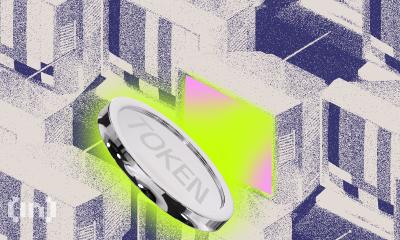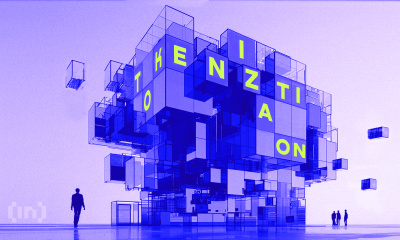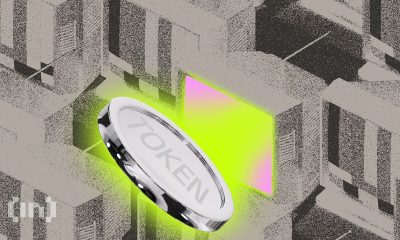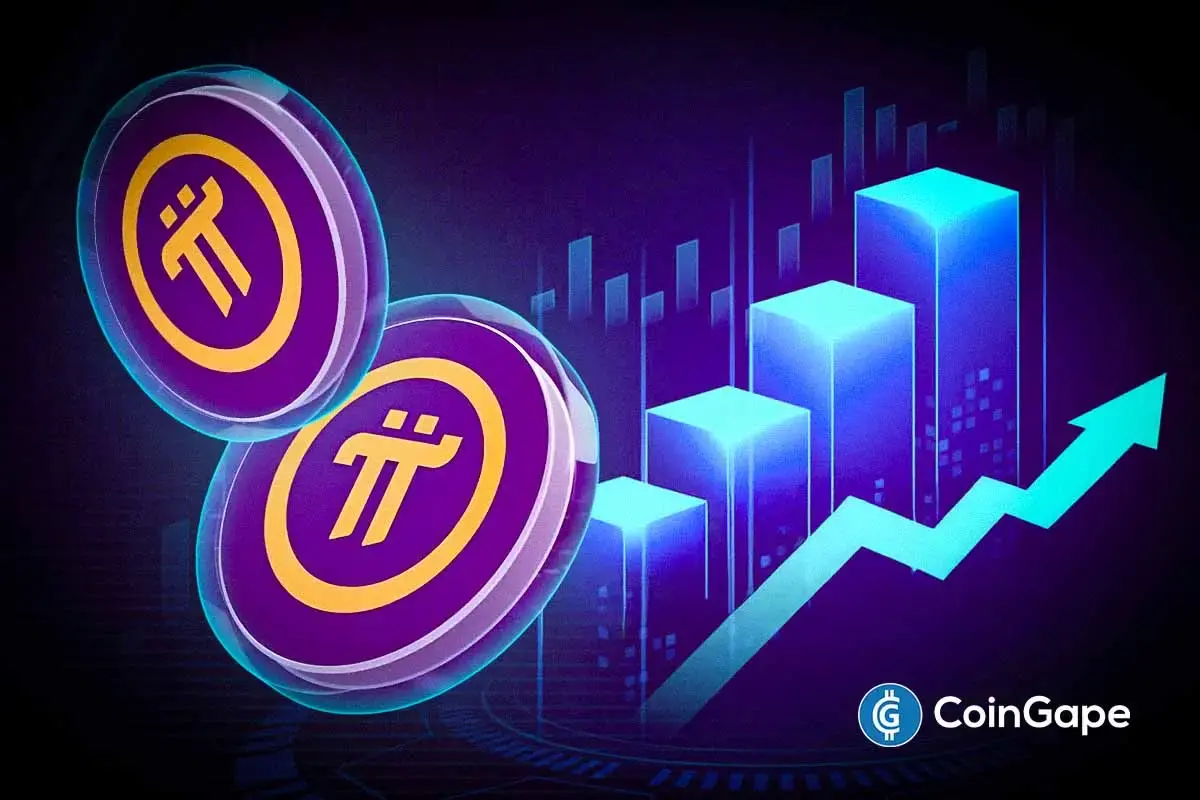Market
How Tokenization Unlocks New Opportunities

The rise of real-world asset (RWA) tokenization is reshaping traditional investment markets, unlocking new opportunities in sectors beyond finance. Though tokenization has historically focused on real estate, precious metals, and fine art, the ability to tokenize tangible luxury goods is now emerging as a transformative force in the industry.
BeInCrypto spoke with Harley Foote, CEO and Co-founder of CryptoAutos, a leading project in the RWA luxury car market, to understand what is driving this new phenomenon’s rise and its future prospects.
RWA Market Growth and Future Potential
Real-world asset tokenization has surged as one of the crypto industry’s dominant narratives in the last few years.
Tokenization leverages blockchain to create digital representations of real-world assets, allowing for fractional ownership. This approach democratizes access to expensive assets by breaking them into more affordable, divisible tokens.
Real estate, commodities, art, financial assets, and precious metals are the most commonly tokenized real-world assets. In 2024, the total market size of tokenized assets reached $186 billion, marking a 32% increase compared to the previous year, according to a report from the Tokenized Asset Coalition.
“The RWA market has exploded in the last year due to a perfect storm of macro trends, technological advancements, and shifting investor sentiment. Institutional interest in blockchain-based assets, ETFs becoming, dare we say, the norm, improved regulatory clarity in key jurisdictions, and the increasing need for liquidity in traditionally illiquid markets have all contributed to this acceleration,” Foote told BeInCrypto.
The industry’s prospects for the future remain promising. According to German consulting firm Roland Berger, the value of tokenized assets is projected to exceed $10.9 trillion by 2030, with real estate, debt, and investment funds leasing as the top three tokenized asset categories.

With RWA tokenization growing, new asset categories are emerging.
The Rise of Tokenized High-End Goods
The tokenization of luxury goods, such as supercars, yachts, jets, and high-end watches, is becoming a transformative trend that is difficult to ignore.
“Initially, RWAs were focused on tokenizing financial instruments like bonds, real estate, and commodities, which made sense. However, as the technology has matured and investors have had their eyes opened and their tastebuds tickled, we’re seeing an expansion into tangible assets with intrinsic scarcity and strong market demand, such as luxury cars, art, and collectibles. Supercars, for example, have traditionally been reserved for ultra-high-net-worth individuals, but that is now a thing of the past due to tokenization,” Foote explained.
In 2020, the crypto startup CurioInvest announced the sale of tokens representing fractional ownership of a 2015 limited-edition Ferrari F12 TDF. They offered these tokens, priced at $1 each, for a vehicle valued at over $1 million. The company also announced plans to tokenize 500 luxury cars, which they intended to store in a warehouse in Stuttgart.
In 2023, Cloud Yachts introduced a novel approach to the yachting industry by launching a tokenized experience related to superyachts.
The NFT company tokenized a 94-foot Sunseeker super yacht, aiming to offer luxury yacht cruises to individuals for a cost comparable to a night out in Miami. It sold each NFT for $500, which granted buyers one cruise around Miami on the Sunseeker 94 for a year.
Tokenized Luxury Vehicles
Earlier this month, CryptoAutos acquired a $20 million luxury car rental fleet in Dubai, featuring limited edition Lamborghini, Ferrari, Porsche, and Rolls Royce models. Customers will have the opportunity to earn USDT through the sale and rental of these vehicles.
According to Foote, luxury goods, particularly supercars, are ideal for tokenization relative to other asset classes.
“Unlike niche financial assets, luxury vehicles have universal appeal and recognition plus a liquid global market that attracts a wide variety of buyers. What sets supercars apart from other luxury assets, like fine art or jewellery, is their potential to generate yield through rentals or shared ownership models, transforming what was traditionally a static asset into a dynamic revenue-generating investment. Additionally, supercars often serve as a hedge against inflation. Much like fine wine, classic watches; supercars tend to outperform traditional-based investments during economic downturns,” he said.
Asset tokenization carves out a unique path toward greater financial inclusion by breaking down ownership into fractions.
Democratizing Luxury Asset Ownership
Luxury vehicles are called that way because only people with a disposable income in the millions can effectively give themselves the luxury to own one. Tokenization changes that.
“Traditional luxury car investments have been restricted to elite collectors with the capital to buy and maintain rare vehicles. Previously, you needed to pay for the whole vehicle but tokenization democratizes access. These new models can allow investors to own a share of high-value assets with minimal capital, trade their holdings in liquid markets rather than waiting for an entire vehicle resale and generate passive income from rental-based yields,” Foote told BeInCrypto.
Several supercars are limited editions, making them particularly well-suited for tokenization.
“The wider car market certainly is a depreciating asset, once they are mass-produced, they are sold and they rarely retain their value. But these are supercars, limited-production hypercars, and classic models. [They] are particularly well-suited for tokenization due to their inherent scarcity, exclusivity, and strong global brand appeal. Limited production runs coupled with collector demand naturally drives up value appreciation over time,” Foote added.
The growth of luxury goods in the RWA industry attracts attention from investors outside the crypto sector, potentially influencing the broader adoption of RWAs in mainstream finance.
“Luxury RWAs serve as a bridge between traditional investors and blockchain-based finance. We see the current progress towards tokenization of luxury assets, like supercars, yachts, and other items, only accelerating as mainstream adoption of RWAs takes hold,” Foote said.
These assets’ reliance on blockchain technology also inspires greater confidence among investors considering luxury goods as a way to diversify their portfolios.
Blockchain’s Role in Curbing Risks
In high-value asset trading, blockchain technology can help ensure transparency, liquidity, and security.
According to Foote, blockchain inherently eliminates many inefficiencies and risks associated with traditional asset ownership by providing transparent ownership at the source.
“Each tokenized asset is recorded on-chain, ensuring a clear ownership history which helps prevent fraud. Unlike traditional methods, investors can trade fractional shares of supercars, eliminating the need for lengthy resale processes. And due to the speed of blockchain technology you aren’t waiting for days for banks to clear your money, you can purchase your car with a few clicks,” he said.
Meanwhile, smart contracts further expedite the process and curb risks.
“Smart contracts enforce legal agreements, revenue-sharing models, and governance mechanisms, reducing the need for intermediaries. While transactions are immutable and tamper-proof, enhancing investor confidence,” Foote added.
Certain jurisdictions are creating regulatory structures to enable confident investor participation in response to the growth of luxury asset tokenization.
Regulatory Frameworks for RWA Tokenization
Different jurisdictions across the globe have implemented regulations for this emerging market, enabling investor access to tokenized RWAs.
“Regulatory frameworks vary widely. Dubai, Switzerland, and Singapore have emerged as favorable jurisdictions for asset tokenization, providing clear legal frameworks and investor protections. Meanwhile, the US and EU are still refining their RWA regulations, but we are seeing promising signs, especially within the US under the new leadership,” Foote told BeInCrypto.
In November 2024, the Monetary Authority of Singapore (MAS) introduced new measures to facilitate the commercialization of tokenized assets. These measures included forming commercial networks designed to enhance liquidity in tokenized assets.
MAS also announced plans to develop a market infrastructure ecosystem and established industry frameworks for implementing and settling tokenized assets.
Meanwhile, Switzerland remains a pioneer in the tokenization sector, supported by its comprehensive legal structure for digital assets. The country’s 2021 Swiss DLT Bill facilitated the secure and compliant tokenization of diverse asset types, drawing international participants to its market.
Even before Singapore and Switzerland, Dubai was the first jurisdiction in the world to implement regulatory clarity for tokenized assets. In 2020, it established the Virtual Assets Regulatory Authority (VARA), a regulatory entity that oversees virtual assets.
This authority focuses on regulating various virtual assets, encompassing tokenized products, cryptocurrencies, and security tokens. Establishing VARA provided regulatory clarity, creating a secure environment for businesses and investors to explore and invest in tokenized assets.
“Dubai is quickly becoming a global hub for tokenized luxury assets due to progressive regulations, strong investor demand, and a thriving crypto ecosystem. We’ve seen multiple projects like Mantra, Reelly, and of course, ourselves, make significant commitments to RWA operations in Dubai so far in 2025,” Foote said.
Yet, before investing in tokenized luxury goods, it’s important to consider their associated risks.
Risks and Future Prospects
Although some countries have established clear regulatory frameworks for virtual assets, most have not. The overall regulatory landscape concerning tokenization is still developing.
Potential regulation changes could impact tokenized assets, requiring investors to remain informed about the changing legal environment.
Meanwhile, tokenized assets, like other investments, are susceptible to market fluctuations. Although tokenization can improve liquidity, it does not mitigate the inherent volatility in asset markets, particularly real estate and commodities.
“We would never shy away from the risks involved, like in any market. Things like market volatility and general economic conditions can impact demand. As can maintenance costs, especially with classic cars, due to the requirements of careful upkeep. And there is the elephant in the room which is regulatory uncertainty. Evolving laws and regulations around tokenized assets could affect investment structures,” Foote told BeInCrypto.
Nonetheless, Foote is certain that the demand for tokenized luxury goods is there and will not disappear anytime soon.
“Investors are increasingly seeking yield-generating luxury assets that offer both utility and appreciation potential. It’s a genuine new frontier that’s opening up right in front of us, and we are taking the opportunity with both hands on that steering wheel and turning the NOS up to the max,” he concluded.
While challenges remain, the appeal of tokenized luxury goods suggests that this is a developing market to watch.
Disclaimer
Following the Trust Project guidelines, this feature article presents opinions and perspectives from industry experts or individuals. BeInCrypto is dedicated to transparent reporting, but the views expressed in this article do not necessarily reflect those of BeInCrypto or its staff. Readers should verify information independently and consult with a professional before making decisions based on this content. Please note that our Terms and Conditions, Privacy Policy, and Disclaimers have been updated.
Market
Will XRP Break Support and Drop Below $2?

XRP is down 5% over the past week, struggling to regain momentum as technical indicators flash mixed signals. Its Relative Strength Index (RSI) has dropped below 50, and the price remains stuck within a tight range between key support and resistance levels.
At the same time, the Ichimoku Cloud has shifted from green to red, with a thickening cloud ahead suggesting growing bearish pressure. With volatility compressing and momentum fading, XRP is nearing a critical point where a breakout—or breakdown—seems increasingly likely.
XRP Struggles to Regain Momentum as RSI Drops Below 50
XRP’s Relative Strength Index (RSI) is currently sitting at 44.54, after recovering from an intraday low of 40.67. Just yesterday, it was at 51.30, highlighting increased short-term volatility.
RSI is a momentum indicator that measures the speed and magnitude of recent price changes to evaluate overbought or oversold conditions.
Readings above 70 typically suggest an asset is overbought, while readings below 30 indicate it may be oversold.

With XRP’s RSI at 44.54, it’s currently in neutral territory, showing neither strong buying nor selling pressure.
However, the fact that it hasn’t crossed the overbought threshold of 70 since March 19—over a month ago—signals a lack of sustained bullish momentum. This could mean XRP is still in a consolidation phase, with the market waiting for a clearer direction.
If RSI continues to climb toward 50 and beyond, it may hint at building momentum, but without a breakout above 70, upside could remain limited.
XRP Faces Uncertainty as Bearish Trend Begins to Expand
XRP is currently trading inside the Ichimoku Cloud, signaling market indecision and a neutral trend.
The Tenkan-sen (blue line) has crossed below the Kijun-sen (red line), which is a bearish signal, but with the price still within the cloud, it lacks full confirmation.
The cloud itself acts as a zone of support and resistance, and XRP is now moving sideways within that zone.
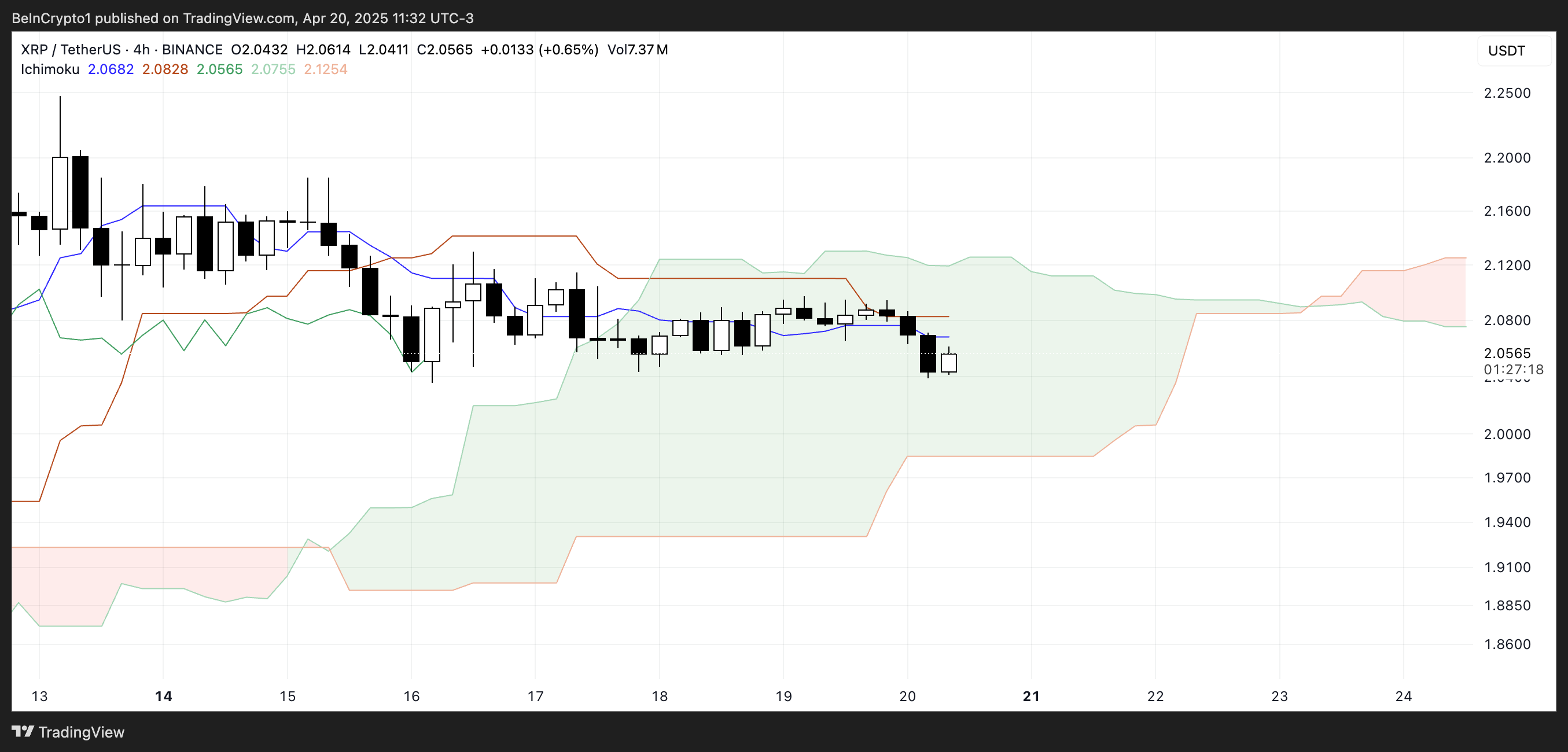
Looking ahead, the cloud has shifted from green to red—a sign that bearish momentum may be building. Even more concerning is that the red cloud is widening, which suggests increasing downward pressure in the near future.
A thickening red Kumo often signals stronger resistance overhead and a potential continuation of a bearish trend if the price breaks below the cloud.
Until XRP breaks out decisively in either direction, the market remains in a wait-and-see phase, but the growing red cloud tilts the bias toward caution.
XRP Compression Zone: A Breakout Could Send Price to $2.50 — Or Much Lower
XRP price is currently trading within a tight range, caught between a key support level at $2.05 and resistance at $2.09. This narrow channel reflects short-term uncertainty, but a decisive move in either direction could set the tone for what’s next.
If the $2.05 support fails, the next level to watch is $1.96. A break below that could trigger a steep drop toward $1.61, which would mark the first close below $1.70 since November 2024—a bearish signal that could accelerate selling pressure.
Recently, veteran analyst Peter Brandt warned that a major correction could hit XRP soon.

On the flip side, if bulls regain control and push XRP above the $2.09 resistance, the next target lies at $2.17. A breakout beyond that could open the door to a move toward $2.50, a price level not seen since March 19.
For that to happen, XRP would need a clear resurgence in momentum and buying volume.
Until then, the price remains trapped in a narrow zone, with both upside and downside potential on the table.
Disclaimer
In line with the Trust Project guidelines, this price analysis article is for informational purposes only and should not be considered financial or investment advice. BeInCrypto is committed to accurate, unbiased reporting, but market conditions are subject to change without notice. Always conduct your own research and consult with a professional before making any financial decisions. Please note that our Terms and Conditions, Privacy Policy, and Disclaimers have been updated.
Market
Dogecoin Defies Bullish Bets During Dogeday Celebration
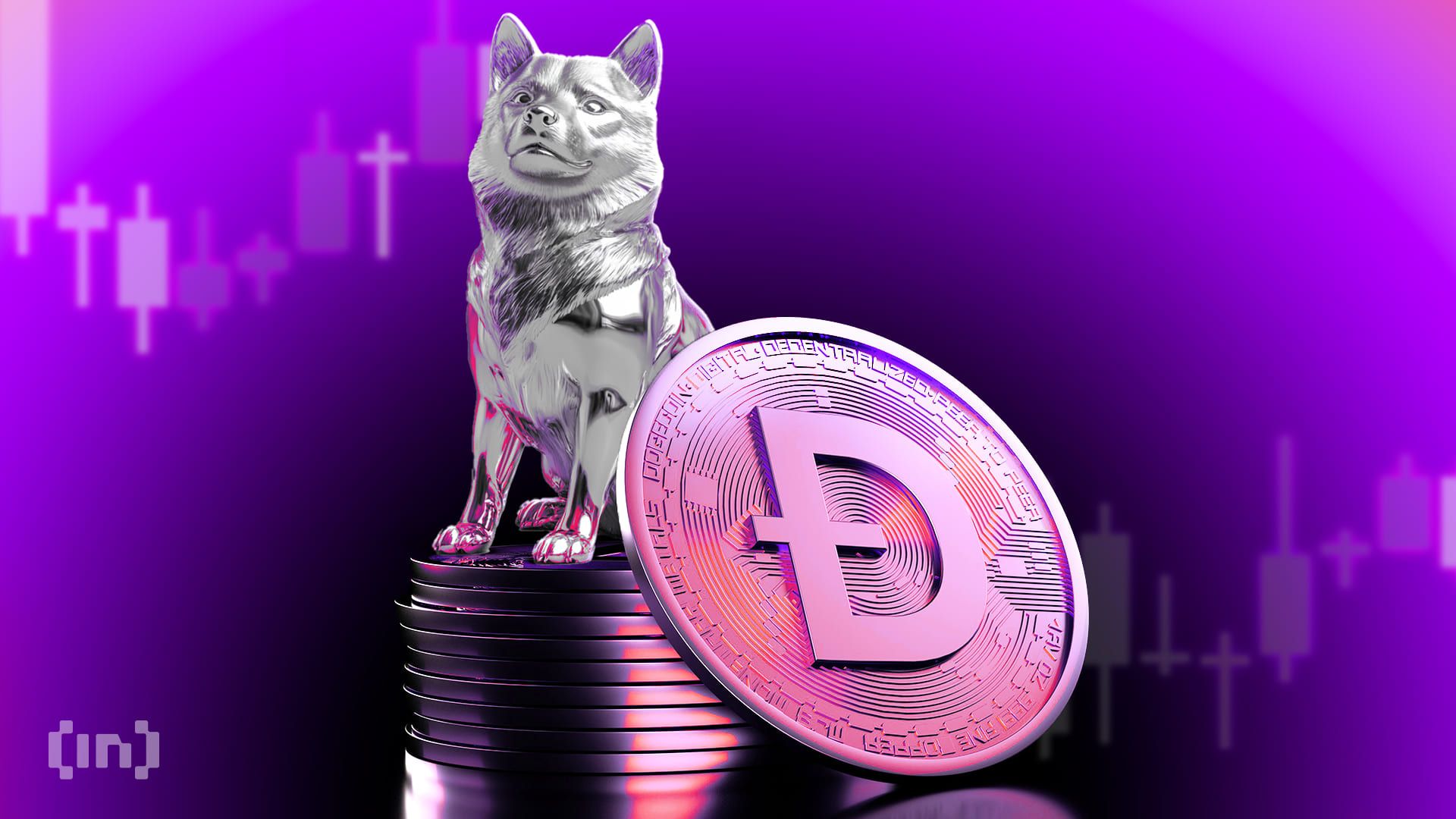
On April 20, Dogecoin enthusiasts worldwide united to mark Dogeday, a community-driven holiday celebrating the world’s most recognizable meme coin.
While the festivities showcased the coin’s loyal fanbase and cultural relevance, the celebration failed to spark any meaningful market movement.
Dogeday Fails to Lift Dogecoin Price as Traders Face $2.8 Million in Liquidations
Instead of riding a wave of positive sentiment, Dogecoin was the worst-performing asset among the top 20 cryptocurrencies during the past day.
According to data from BeInCrypto, the token dropped over 2.5% during the reporting period compared to the muted performance of the general market.
This disappointing performance led to roughly $2.8 million in liquidations, with traders betting on an upward price movement losing more than $2 million, per Coinglass figures.
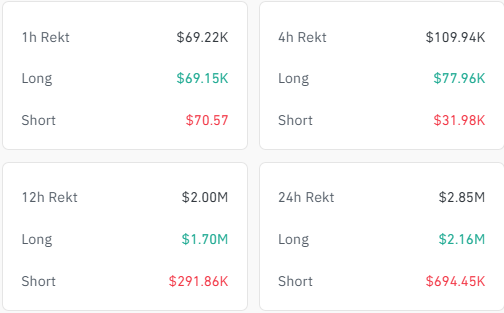
However, even with the lackluster price action, Dogecoin’s relevance in the crypto ecosystem remains undeniable. Launched in 2013 as a parody of Bitcoin, DOGE has grown far beyond its meme origins.
The digital asset is now the ninth-largest cryptocurrency by market capitalization, currently valued at approximately $22.9 billion, according to CoinMarketCap.
Much of its growth can be attributed to high-profile endorsements. Tesla CEO and presidential advisor Elon Musk has repeatedly voiced support for Dogecoin, as has billionaire entrepreneur Mark Cuban. Their backing helped shift public perception of DOGE from a joke to a legitimate digital asset and payment option.
On social media, Dogecoin continues to lead the memecoin narrative. According to CryptoRank, it was the most mentioned memecoin ticker on X (formerly Twitter) in the past month. This visibility continues to fuel both community engagement and investor interest.

Moreover, institutional interest in Dogecoin is also on the rise. Major asset managers, including Bitwise, Grayscale, 21Shares, and Osprey, have submitted filings to the US Securities and Exchange Commission (SEC) seeking to launch spot Dogecoin ETFs.
If granted, these financial investment vehicles could become the first exchange-traded funds centered entirely on a meme coin.
Considering this, crypto bettors on Polymarket put the odds of these products’ approval above 55% this year. This optimism reflects a growing belief that Dogecoin could soon secure a place in mainstream financial markets.
Disclaimer
In adherence to the Trust Project guidelines, BeInCrypto is committed to unbiased, transparent reporting. This news article aims to provide accurate, timely information. However, readers are advised to verify facts independently and consult with a professional before making any decisions based on this content. Please note that our Terms and Conditions, Privacy Policy, and Disclaimers have been updated.
Market
Tokens Big Players Are Buying

Crypto whales are making bold moves heading into May 2025, and three tokens are standing out: Ethereum (ETH), Artificial Superintelligence Alliance (FET), and Onyxcoin (XCN). All three have seen a noticeable uptick in large-holder accumulation over the last week, signaling growing interest from big players despite recent volatility.
While ETH and XCN are both coming off sharp corrections, whale buying suggests confidence in a potential rebound. Meanwhile, FET is riding renewed momentum in the AI sector, with whale activity accelerating alongside rising prices.
Ethereum (ETH)
The number of Ethereum crypto whales—wallets holding between 1,000 and 10,000 ETH—has been steadily climbing since April 15. Back then, there were 5,432 such addresses.
That number has now risen to 5,460, the highest count since August 2023. At the same time, the concentration of ETH held by these whales is also hitting new highs, signaling growing accumulation by large holders.
While this can be interpreted as confidence in Ethereum’s long-term value, it also raises concerns about centralization and potential selling pressure if whales decide to take profits.

Ethereum price is currently down more than 19% over the last 30 days. If the correction continues, the price could retest support at $1,535. Losing that level might send ETH toward deeper support at $1,412 or even $1,385.
However, if the trend reverses, key resistance zones lie at $1,669 and $1,749—with a potential push toward $1,954 if bullish momentum builds.
In this context, the growing dominance of whales could act as either a stabilizing force or a looming risk, depending on how they respond to market shifts.
Artificial Superintelligence Alliance (FET)
The number of FET whales—wallets holding between 10,000 and 1,000,000 tokens—increased from 572 on April 13 to 586 by April 19.
This steady growth in large holders points to rising confidence among bigger players. It comes at a time when the broader AI crypto narrative is showing signs of a rebound.
Key AI coins like FET, TAO, and RENDER have all increased over 9% in the last seven days, with FET itself gaining more than 8% in the past 24 hours and 13.5% over the week. This suggests a possible comeback for the artificial intelligence narrative in crypto.
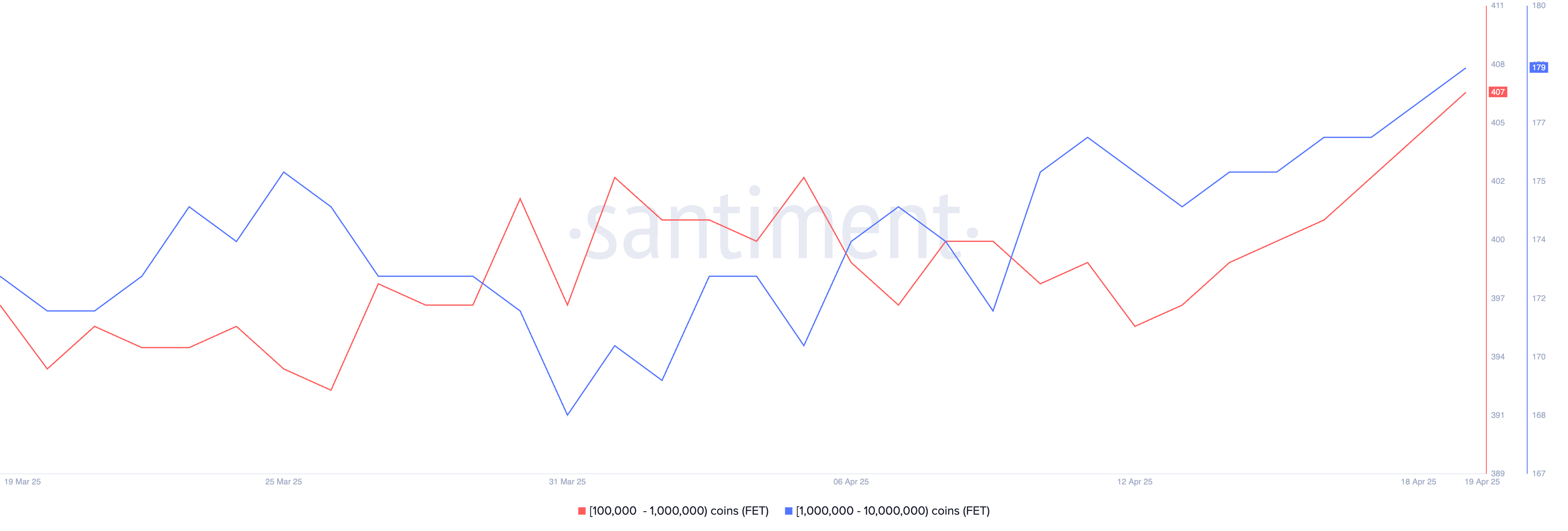
If this momentum continues, FET could push toward resistance at $0.659. A clean breakout from that level could open the door to further gains, with $0.77 and $0.82 as the next potential targets.
On the flip side, if the rally stalls, FET might drop back to test support at $0.54. A breakdown below that could send it as low as $0.44.
With whale activity heating up and the AI sector showing renewed strength, FET’s next move could be a key signal for where the narrative heads next.
Onyxcoin (XCN)
Onyxcoin was one of the standout performers in January, but its momentum has faded in recent months. After a strong bounce—up of over 57% in the last 30 days, the token is now correcting, down 19% in the past seven days.
Despite this pullback, accumulation continues. The number of crypto whales holding between 1 million and 10 million XCN has grown from 528 on April 16 to 541, suggesting some large holders may be buying the dip.

If the correction deepens, XCN could lose support at $0.0165. A drop below that may open the door to further declines toward $0.0139 and $0.0123.
But if the trend flips back upward, the token could first test resistance at $0.020. A strong breakout from there might lead to a move toward $0.027. With whale activity on the rise and volatility returning, XCN’s next move could be decisive.
Disclaimer
In line with the Trust Project guidelines, this price analysis article is for informational purposes only and should not be considered financial or investment advice. BeInCrypto is committed to accurate, unbiased reporting, but market conditions are subject to change without notice. Always conduct your own research and consult with a professional before making any financial decisions. Please note that our Terms and Conditions, Privacy Policy, and Disclaimers have been updated.
-

 Altcoin20 hours ago
Altcoin20 hours agoUniswap Founder Urges Ethereum To Pursue Layer 2 Scaling To Compete With Solana
-

 Ethereum16 hours ago
Ethereum16 hours agoEthereum Consolidates In Symmetrical Triangle: Expert Predicts 17% Price Move
-
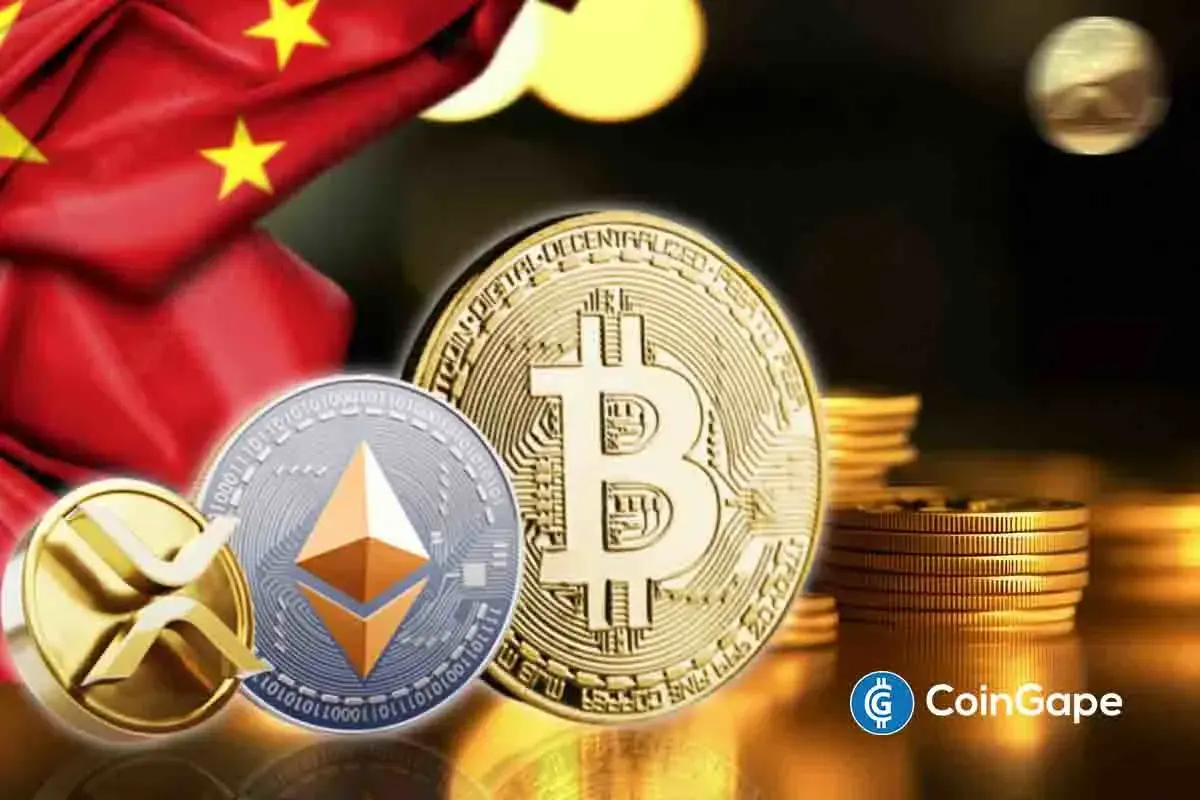
 Altcoin19 hours ago
Altcoin19 hours agoWhat’s Up With BTC, XRP, ETH?
-

 Market16 hours ago
Market16 hours agoToday’s $1K XRP Bag May Become Tomorrow’s Jackpot, Crypto Founder Says
-

 Bitcoin23 hours ago
Bitcoin23 hours agoAnalyst Says Bitcoin Price Might Be Gearing Up For Next Big Move — What To Know
-

 Ethereum18 hours ago
Ethereum18 hours agoEthereum Accumulators At A Crucial Moment: ETH Realized Price Tests Make-Or-Break Point
-
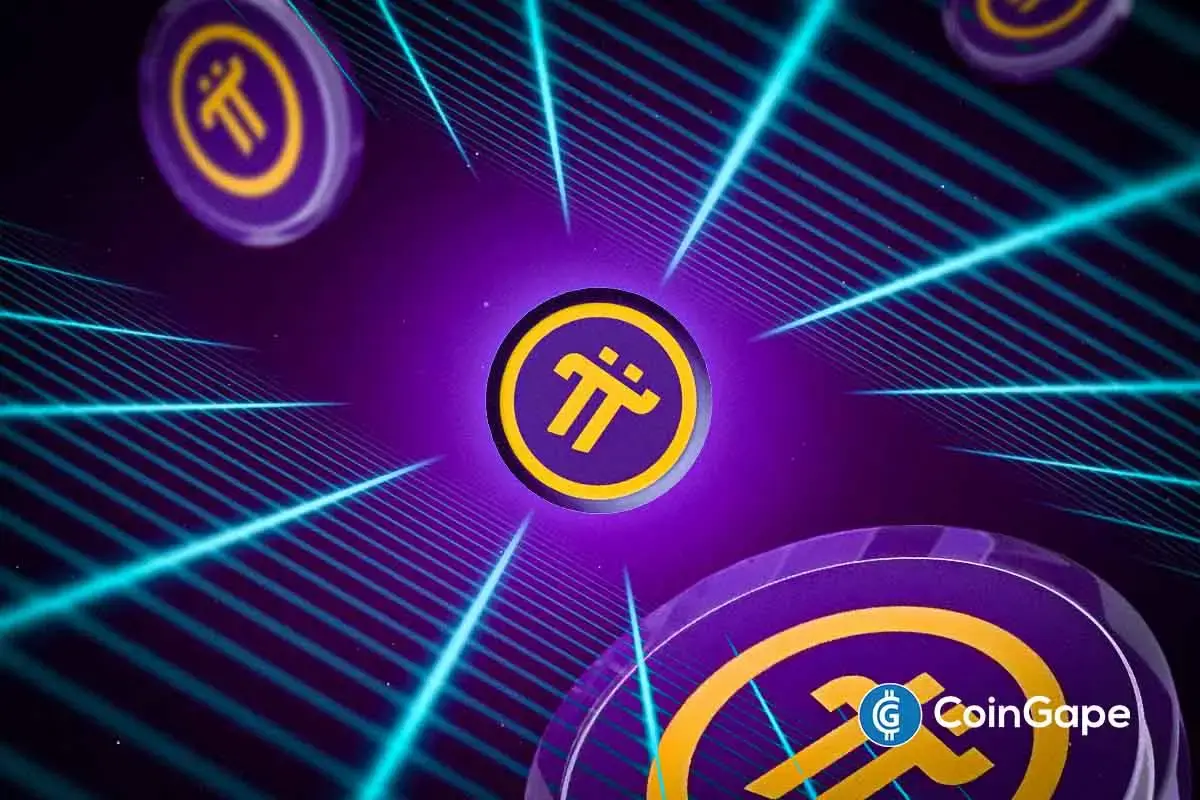
 Altcoin23 hours ago
Altcoin23 hours agoExpert Reveals Why Consensus 2025 Will Be Pivotal For Pi Network
-

 Market9 hours ago
Market9 hours ago1 Year After Bitcoin Halving: What’s Different This Time?


